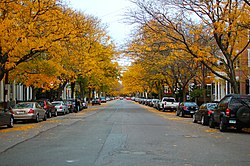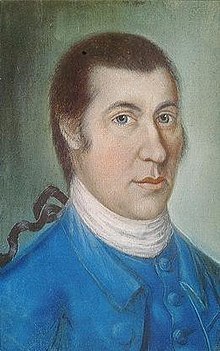Chestnut Street District
Chestnut Street District | |
 Looking east on Chestnut Street in the fall | |
 | |
| Location | Roughly bounded by Bridge, Lynn, Beckford, and River Sts., Salem, Massachusetts |
|---|---|
| Coordinates | 42°31′13″N 70°54′8″W / 42.52028°N 70.90222°WCoordinates: 42°31′13″N 70°54′8″W / 42.52028°N 70.90222°W |
| Area | 45 acres (18 ha) (original size) 2.5 acres (1.0 ha) (size of 1978 increase) |
| Built | 1651 |
| Architect | Multiple |
| Architectural style | Mid 19th Century Revival, Colonial, Federal |
| NRHP reference No. | 73000312[1] (original) 78000468 (increase) |
| Significant dates | |
| Added to NRHP | August 28, 1973 |
| Boundary increase | October 4, 1978 |
The Chestnut Street District is a historic district bounded roughly by Bridge, Lynn, Beckford, and River Streets in Salem, Massachusetts. It was added to the National Register of Historic Places in 1973 and enlarged slightly in 1978. The district contains a number of architecturally significant works of Samuel McIntire, a builder and woodworker who had a house and workshop at 31 Summer Street, and who designed and built a number of these houses, and others that display the profits made in the Old China Trade by Salem's merchants. The district is a subset of a larger locally designated McIntire Historic District.[2]

Saunders House[]
The first of the great brick Federal houses to be constructed was the Thomas Saunders House at number 39 Chestnut, built in 1805 and later remodeled by Arthur Little (1893). Saunders also built the famous McIntire-designed double house next door at numbers 41-43, in 1810, as a wedding present for his daughters Mary Elizabeth and Caroline, who married brothers Leverett and Nathaniel Saltonstall. Leverett Saltonstall I was Salem's first elected mayor.[3]
Hamilton Hall[]
Hamilton Hall is a National Historic Landmark at 9 Chestnut Street in Salem, Massachusetts.[4] Hamilton Hall was built in 1805 by Samuel McIntire and added separately to the National Register of Historic Places in 1970.[1][5]
Ropes Mansion[]
The Ropes Mansion (late 1720s), also called Ropes Memorial, is a Georgian Colonial mansion located at 318 Essex Street. It is now operated by the Peabody Essex Museum and open to the public.
Peirce-Nichols House[]
The Peirce-Nichols House (ca 1782), is an elegant example of late-Georgian craftsmanship. It is located at 80 Federal Street, and was built for Jerathmiel Peirce, partner in the shipping firm of Waite & Peirce, owners of the Friendship and several other ships. Designed early in the career of Samuel McIntire (1757–1811), and modified later by him, the building gives a unique view into his methods and styles. It was designated a National Historic Landmark in 1973, and is now owned by the Peabody Essex Museum, which offers guided tours.

Stephen Phillips House[]
The Stephen Phillips House is located at 34 Chestnut Street. A classic car show is held every year[6] at The Stephen Phillips House. The Phillips House is now owned and operated as a historic house museum by Historic New England and is open for public tours.
Pickering House[]
The Pickering House (circa 1651) is a Colonial house, owned and occupied by ten successive generations of the Pickering family including Colonel Timothy Pickering.[7] This house is believed to be the oldest house in the United States continuously occupied by one family. It is located at 18 Broad Street, Salem, Massachusetts and is open to the public under the auspices of the nonprofit Pickering Foundation.
The Witch House, Jonathan Corwin House[]
The Witch House (also called the Jonathan Corwin House), was the home of Judge Jonathan Corwin[8] and is the only structure still standing in Salem, Massachusetts with direct ties to the Salem Witch Trials of 1692.[9]
The Salem Athenaeum[]
The Salem Athenaeum was founded in 1810 and is one of the oldest private library organizations in the United States. The Athenaeum is located at 337 Essex Street. In 1905, the Athenæum sold the building at 132 Essex Street to the Essex Institute (now the Peabody Essex Museum), and with the proceeds constructed the building it currently occupies, at 337 Essex Street. Dedicated in 1907
Francis Cox House[]
The Francis Cox House was built in 1846 and is situated at the corner of Chestnut and Summer street.[10]
John Bertram Mansion[]

This High Style Italianate brick and brownstone mansion was built at 370 Essex Street in 1855 for Captain John Bertram[11] When Captain John Bertram died in March 1882, his widow donated their home (The John Bertram Mansion) and this became the Salem Public Library.[12] The Salem Public Library opened its doors on July 8, 1889.
See also[]
- List of the oldest buildings in Massachusetts
- List of the oldest buildings in the United States
- List of historic houses in Massachusetts
- National Register of Historic Places listings in Salem, Massachusetts
- National Register of Historic Places listings in Essex County, Massachusetts
References[]
- ^ a b "National Register Information System". National Register of Historic Places. National Park Service. April 15, 2008.
- ^ "McIntire Historic District". salemweb.com. Retrieved 2017-07-11.
- ^ Broaddus, Will. "Tales of Chestnut Street".
- ^ "Hamilton Hall". Hamilton Hall.
- ^ "Hamilton Hall NHL listing info". Archived from the original on 2011-06-06. Retrieved 2011-09-08.
- ^ "Thanks: Many enjoyed Chestnut Street car show". Salem News.
- ^ "Pickering House". pickeringhouse.org.
- ^ "Archived copy". Archived from the original on 2012-04-13. Retrieved 2012-03-29.
{{cite web}}: CS1 maint: archived copy as title (link) - ^ "The Witch House (Jonathan Corwin House), Salem, Massachusetts". www.salemweb.com.
- ^ "Salem Massachusetts - Salem Architecture 19th & 20th Centuries: Overview". www.salemweb.com.
- ^ "Archived copy". www.noblenet.org. Archived from the original on 9 February 2013. Retrieved 12 January 2022.
{{cite web}}: CS1 maint: archived copy as title (link) - ^ "Archived copy". Archived from the original on 2014-07-08. Retrieved 2013-05-05.
{{cite web}}: CS1 maint: archived copy as title (link)
- 1973 establishments in Massachusetts
- Historic districts in Essex County, Massachusetts
- Historic districts on the National Register of Historic Places in Massachusetts
- History of Salem, Massachusetts
- National Register of Historic Places in Salem, Massachusetts
- Protected areas established in 1973
- Tourist attractions in Salem, Massachusetts


